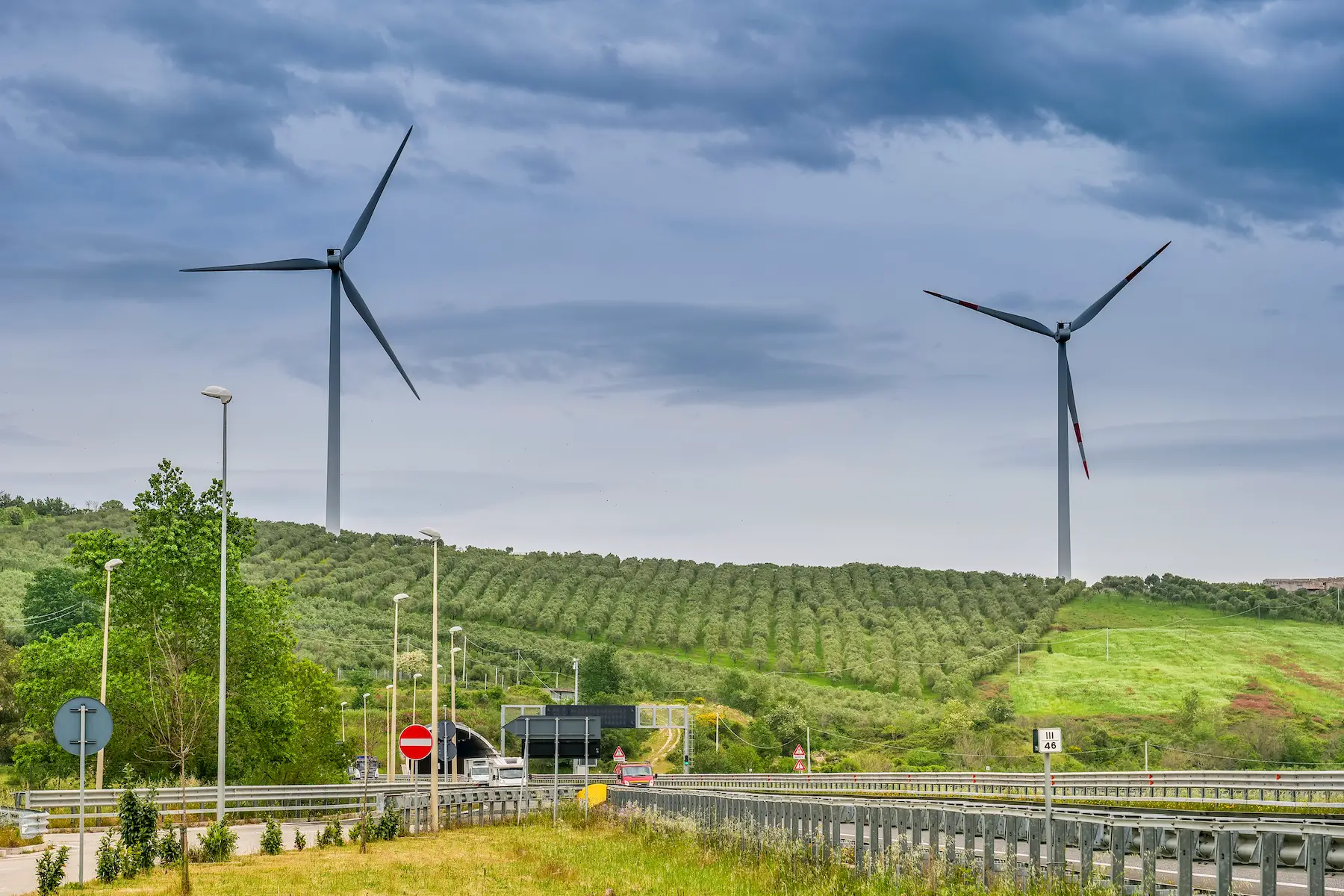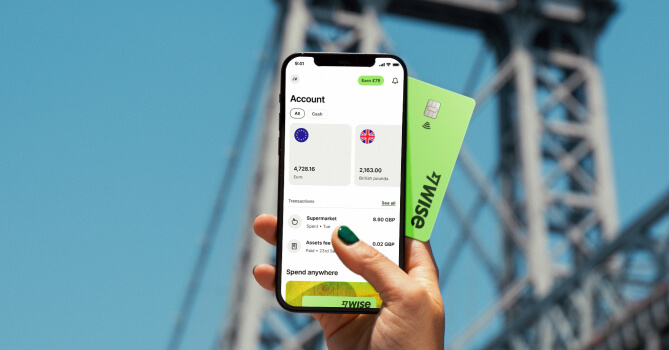With top-notch cuisine, world-famous art and architecture, and a stunning coastline, there are many reasons to fall in love with Italy. But before you make the big move abroad, it’s worth familiarizing yourself with local living costs.
Whether you’re relocating for work or lifestyle reasons, you’ll need to manage your finances efficiently, including any money transfers between Italy and your home country. Multi-currency accounts like Wise can help you manage your finances easily. More on that later.
From groceries and healthcare to housing and utilities, here’s what you need to know:
Wise account
Are you an expat or thinking of moving to Italy? Managing your money across borders shouldn’t be complicated. With a Wise account, you can hold over 40 currencies and pay with a Wise debit card in more than 150 countries. Whether you need to spend abroad, receive or send money home, Wise can help make international money management simpler.
What is the state of Italy’s economy?
Italy is the third-largest economy in the European Union (EU), trailing behind only Germany and France. Its gross domestic product (GDP) is €2.1 billion. However, its GDP per capita is €28,880, below the EU average of €29,280.
Despite its high GDP, the Italian economy is experiencing stunted growth. The European Commission (EC) predicts the GDP will grow by 1% in 2025 and 1.2% in 2026. This is below the expected EU growth of 1.5% and 1.8% in 2025 and 2026 respectively.

Italy’s status as the third-richest country in the EU seems paradoxical. The equivalised disposable income (i.e., the total net income of all household members divided by the weighted number of household members) is €19,819 per person. This is slightly below the EU average of €20,350 per person (2023).
More importantly, 19.2% of Italians are at risk of poverty, and 8.4% of people can’t afford a meal with meat, chicken, fish, or a vegetarian equivalent every second day (2023). These percentages are comparable to Croatia and Czechia, where 18.8% and 21.7% of the population (respectively) are at risk of poverty.
Italy’s National Statistics Institute (Instituto Nazionale di Statistica – Istat) paints an even grimmer picture, reporting that 18.9% are at risk of poverty and 22.8% may experience social exclusion.
Inflation and disposable income in Belgium
In terms of purchasing power, the average headline inflation for 2025 is projected to be 1.9%, well below the European Union’s average of 2.4%. This figure is likely to decline to 1.7% in 2025, again below the EU average of 2%.
Italy has a slightly lower average disposable income ($29,431) than the OECD average ($30,490). You can read more about average salaries and incomes in our article on minimum wage in Italy.
Italy compared to its neighbors
Italy’s total GDP is comparable to its neighbors, the strong economies of France, Switzerland, and Austria. Meanwhile, its northeastern neighbor, Slovenia, has a smaller, but much faster-growing economy.
As a founding member of the EU, Italy benefits from strong trade ties with nearby countries. Its location in the Mediterranean also makes it an international trade hub. Italy is the 8th-largest exporter and 12th-largest importer in the world, and its main trade partners are Germany, the US, and France.
Its leading exports are packaged medicaments, cars, and refined petroleum.
The cost of living in Italy in 2025
According to Istat, the average household expenses in Italy in 2023 accumulated to around €32,736 per year (or €2,728 per month (in Italian)). This cost of living is the highest in at least a decade.
The average cost of living spending per region in Italy was:
| Annually | Monthly | |
| North (Nord) | €35,580 | €2,965 |
| Center (Centro) | €35,436 | €2,953 |
| South (Mezzogiorno) | €26,808 | €2,234 |
Breaking down the costs:
| Alcohol and tobacco | €44 | Transportation | €289 |
| Food and drink | €525 | Culture, sports, and recreation | €101 |
| Housing and utilities | €982 | Restaurants and hotels | €155 |
| Healthcare | €117 | Education | €16 |
| Internet and telecom | €74 | Other | €323 |
| Clothing and footwear | €102 | ||
| Total | €2,728 |
Considering the 2024 inflation rate of 1.1% and the 2025 inflation rate of 1.9%, it’s recommended that your monthly budget have at least €2,810 per household.
If you are looking for ways to manage your money in Italy effectively, the following banks and financial services can help you out:
- Atlantic Money – an international money transfer service
- Hype – an app for online accounts and money management
- N26 – a global online bank
- Tinaba IT – an app for online accounts and money management
- XE Money Transfer – a global currency converter and money transfer platform
Keep reading for an overview of the cost of living expenses you might come across in your daily life.
The price of groceries in Italy in 2025
Food and drink
Groceries are the second-largest expense after housing costs. In 2023, Italians spent an average of €525 per month on food and non-alcoholic drinks (North: €510, Center: €527, South: €547).

The average price ranges* of basic supermarket items include:
| Product | Price range | Product | Price range |
| Apples (1 kilo) | €1.30–2.60 | Potatoes (1 kilo) | €1.50–2.30 |
| Bread (1 loaf) | €0.90–4.40 | Regular milk (1 liter) | €1.50–2.20 |
| Cheese (1 kilo) | €3.20–55.30 | Rice (1 kilo) | €2.10–10.00 |
| Coffee (1 kilo) | €8.90–31.80 | Tea (per bag) | €0.03–0.30 |
| Eggs (12) | €2.63–6.78 | Tomatoes (1 kilo) | €1.98–12.30 |
| Orange juice (1 liter) | €1.30–8.00 | Water (1 liter) | €0.12–1.94 |
Beer, wine, and liquor
To state the obvious, Italy offers some great alcoholic beverage choices. You can get anything from Birra Peroni to Black Rooster Chianti (with liver and some fava beans) and everything in between. In 2023, the country was the second-largest wine exporter in the EU after France. Italian drinkers consume around 6.6 liters of pure alcohol per year (2020), with most people preferring wine.
In 2023, households spent an average of €44 per month on alcohol and tobacco products. More specifically, €47 in the North, €48 in the Center, and €39 in the South.
A local beer in a bar or restaurant costs between €3.00–6.00, which goes up to €5–8 for craft brews. A bottle of wine, on the other hand, will set you back around €5.00–8.00.
Alcohol is – naturally – cheaper in supermarkets. You can expect to find a domestic beer for as little as €0.59–1.33, depending on the make and size. A decent wine will set you back €3–15 per bottle. The price of most liquor (e.g., limoncello, grappa, or vodka) starts from €5.20, depending on your drink of choice.
Hygienic and household products
Hygienic and household products include everything from toothpaste and shampoo to dish soap (or washing-up liquid) and toilet bleach. The average price ranges* of these necessities include:
| Product | Price range | Product | Price range |
| All-purpose cleaner (1 liter) | €1.85–5.65 | Shampoo (1 liter) | €1.25–29.95 |
| Deodorant (150 ml) | €1.90–9.55 | Soap (1 bar) | €1.00–3.00 |
| Dish soap (1 liter) | €1.00–4.55 | Tampons (per tampon) | €0.17–0.30 |
| Garbage bags (per bag) | €0.03–€0.49 | Toilet paper (per roll) | €0.27–1.25 |
| Laundry detergent (1 liter) | €1.80–9.80 | Toothpaste (75 ml) | €1.20–7.05 |
Housing costs
In 2023, the average housing costs were roughly €982 per household (North: €1,076, Center: €1,107, South: €763). This included rent and mortgage payments, water, electricity, gas and other fuels, and renovation costs.

Rent and property prices
Property prices differ tremendously throughout Italy. Houses in Florence (Firenze), Milan (Milano), Rome (Roma), and other popular cities are comparatively more expensive than rural areas and less well-known cities.
As of December 2024, the average rent for a home in Italy is €13.90 per square meter. With the average home being 81 square meters, that would mean a monthly rent of roughly €1,125. Potential homeowners will pay an average of €1,798 per square meter.
Depending on the location, you’ll pay the following average housing prices:
| Average monthly rent* | Average rent per square meter | Average property price per square meter | |
| Bologna | €1,507 | €18.60 | €3,460 |
| Naples (Napoli) | €1,288 | €15.90 | €2,869 |
| Rome | €1,401 | €17.30 | €3,040 |
| Torino | €956 | €11.80 | €1,876 |
| Verona | €1,013 | €12.50 | €2,408 |
The most expensive places are Alassio, Forte dei Marmi, Milan, and Pietrasanta. However, if you’re looking to live in Italy on a budget, the cheapest cities to move to are (as of July 2024):
| To rent: | Average monthly rent* | Average rent per square meter | To buy: | Average property price per square meter |
| Caltanissetta | €365 | €4.50 | Caltanissetta | €643 |
| Reggio Calabria | €437 | €5.40 | Ragusa | €736 |
| Ragusa | €478 | €5.90 | Biella | €788 |
| Taranto | €462 | €6.30 | Reggio Calabria | €823 |
| Cosenza | €510 | €6.40 | Isernia | €859 |
| Trapani | €535 | €6.60 | Agrigento | €876 |
Learn more about the real estate market and property prices by reading our articles on buying property and renting in Italy. Our country article on where to live highlights popular residential areas for expats.
When renting an apartment or purchasing property in Italy as an expat, you’ll likely need to transfer large amounts of money from your home country. High transfer fees and unfavorable exchange rates might often be charged for these large international transfers.

Using a specialized service like Wise can save you significant amounts by offering the mid-market exchange rate with transparent, low fees. Wise also offers automatic fee discounts on larger transfers, and has a dedicated support team for large transfers. This can be especially valuable when transferring the initial deposit for your new rental apartment or the down payment for a property.
Utility bills: water, gas, electricity
Italy has one of the highest utility costs in the EU. Depending on your use and property price, you can expect to pay around €120–310 per month on utilities in 2025.
Of course, the price of water, gas, and electricity differs per region (and especially climate). For example, annual water bills in 2022 were as little as €181 in Molise and as high as €770 in Tuscany. Similarly, Italy is divided into six payment zones for gas use. As such, residents in Palermo spend less than one-third on gas than households in Milan.

According to the Italian consumer group Cittadinanzattiva (Rapporto Acqua, 2024), the average price of water in Italy is €2.62/cubic meter (North: €2.35/m3, Center: €3.57/m3, South: €2.38).
The EC reports that, during the first half of 2024, Italian households paid €0.085 kilowatt/hour for gas (EU average: €0.0802) and €0.2451 kilowatt/hour (EU average: €0.2187) for electricity.
You can find out more about payment zones and providers in our article on utilities in Italy.
Italian healthcare costs
Everyone living and working in Italy must register for healthcare. The country’s public system has (almost) universal medical coverage, though some payments are required for medication and certain procedures.
Many local and expat residents choose to take out supplemental private health insurance. This provides them with shorter waiting times and a wider choice of doctors and specialists, plus extra coverage for other healthcare, such as dentistry or vision care.
Basic insurance packages start at €50 a month. The more comprehensive the plan, the higher the premium will be. Older adults and those with pre-existing conditions may also pay more with private insurance.

In 2023, households spent a monthly average of €117 on healthcare (North: €122, Center: €135, South: €99).
Internet and telecom
While relatively inexpensive, the cost of internet and other telecommunication services in Italy varies per location and the type of connection or service. You can often get a discount when you get a telecom package that includes TV, internet, and home phone.
You can install fiber broadband for as low as €29.99 a month (excluding installation), though your internet speed might not be great. Of course, the price rises if you want to increase the speed or add (more) TV channels.
Mobile phone data plans are also cheap. For example, Ho.Mobile offers 5G plans from as little as €5.99. In 2023, average monthly communication costs in Italy amounted to around €74 per household (North: €79, Center: €81, South: €60).
Clothing and footwear costs in Italy
The price of clothes and shoes in Italy is in line with other EU countries. In 2023, Italians spent €102 (North: €99, Center: €106, South: €103) per month on their wardrobe.
The cost of clothing and footwear varies greatly, depending on the type and brand. For example, underwear costs around €3–10. Dresses and jeans, on the other hand, cost between €30–120. Business shoes for men and women range from €40–200.

Designer clothing can sell for hundreds or even thousands of euros. However, many luxury brands tend to be cheaper in Italy than elsewhere in the world because the clothing is often designed and made there.
Transportation
In 2023, the average cost of transportation was €289 per month (North: €333, Center: €306, South: €213).
Public transport
Italy has a decent public transportation network of bicycles, buses, metros, and trains at affordable prices. These are run locally, so fares and availability differ on where you are.
- Rome – a 100-minute ticket costs €1.50, while a day ticket costs €7.00
- Milan – travel for 90 minutes for €2.20; daily tickets cost €7.60
- Naples – check the ANM website for prices
- Turin – a single ticket costs €1.90 (€2.00 for a paper ticket) and a day ticket is €3.70 (€4.50 if on paper)
You can also hire public bicycle services for €0.50–1.00 per hour in the following cities:
If you are planning to commute to work, it’s recommended you get a monthly or yearly plan to travel at a discounted cost.

Writer
Joana Taborda
Insider tip
Longer trips between cities will be more expensive. For example, traveling from Rome to Milan on a high-speed train can cost €100. However, you can catch a slower train and pay half the price.
Driving and vehicle costs
Compared to public transport, having your own car in Italy is relatively expensive. According to the 2022 Car Cost Index, the average annual cost for car owners is around €1,062.

Beyond the initial costs of lessons, a driving license, and the actual purchase of the vehicle, you’ll need to budget for:
- Car insurance – the average annual car insurance premium in Italy in 2023 was €316, but this depends on your insurance class, vehicle type, driving history, type of policy, and location. For new drivers, this can reach a couple of thousand euros per year.
- Annual Road Tax – the amount depends on the region, as well as the power of the vehicle (kW/t) and the environmental class.
- Fuel costs – as of February 2025, gasoline costs €1.83 per liter, and diesel costs €1.74 per liter.
- Maintenance – vehicle inspection every two years costs between €45 and €80.
Our article on driving in Italy covers more about costs, mandatory insurance, and driving regulations.
Leisure activities
In 2023, the average person spent €101 per month on culture, sports, and recreation (North: €123, Center: €118, South: €59). Italians also spent €155 per month on hotels and restaurants (North: €199, Center: €162, South: €84).
Movie theaters and cinemas
A standard weekday movie ticket in Italy costs around €5–8, which is much cheaper than, for example, the Netherlands and France. On Friday evenings and during the weekend, ticket prices go up to €9–12.
Restaurants
Depending on your taste and date night, dining out can be relatively cheap. A meal at an inexpensive restaurant costs around €15–25. On the other hand, a three-course meal at a mid-range restaurant can set you back €60–100.

Of course, these estimates will vary on your location. Restaurants are more expensive in touristic areas, especially when you don’t speak Italian.
Sports
If you are planning to join a gym, you can expect to pay about €30–80 a month, depending on your location and membership. For example, Milan is more expensive than other cities.
It’s worth noting that you’ll typically need a medical certificate before you can sign up for a gym plan.
Education and childcare
On average, people will roughly spend €16 per month on education (North: €20, Center: €17, South: €9). This cost of living expense does not include childcare in Italy.
Childcare
Mandatory education for children starts at age six, so working parents with young children may need to arrange childcare from time to time. In Italy, options include nurseries, preschools or kindergartens, and independent childminders.

Babies and toddlers (ages 0–3) can attend public nurseries, which usually charge according to the family’s income. From the ages 3–5, children can go to public preschools, which also charge a fee depending on your income. There are no free after-school childcare options available for older children.
Because public nurseries and preschools operate primarily in Italian, many expat residents choose to hire a nanny or au pair instead. A nanny in Italy will charge around €12 an hour, while an au pair will cost about €250–300 a month. Note that for this option, you also need to provide food and lodging.
Children’s education
Public schools in Italy are funded by resident taxpayers. There are no tuition fees, and parents only need to pay for books and materials. Lessons are held in Italian, and some parents prefer to send their children to a bilingual or private school. These obviously have tuition fees that vary widely depending on the school’s curriculum, location, and reputation.
For example, the cost of an international primary school ranges from €5,000–10,000 per year. This can go up to €25,000/year for high school students. Parents will also need to take into account the costs of transport, uniforms, extracurricular activities, and materials.
Discover more about global school curriculums and fees in our article on international schools in Italy.
University tuition fees
Although not completely free, Italy has one of the lowest college tuition rates in the world. The average cost of a degree from a public university ranges from €500–3,000 per year. Tuition fees at private universities are substantially higher and can reach up to €25,000 per year.
Read our article on studying in Italy to find out more about degree programs and costs.
How does Italy compare to the rest of the world?
Italy has a mixed score on the OECD Better Life Index, which measures standards of living. The country outperforms the average in health, work-life balance, and civic engagement. However, it ranks low on income, employment, education, environmental quality, social connections, and life satisfaction.
The Wisevoter Human Development Index, on the other hand, ranks Italy as having the 30th best standard of living in the world.

The highest Italian city on Mercer’s 2024 quality of living index is Milan (42nd), which is below Amsterdam (6th) and Paris (34th), but above Dublin (43rd) and Rome (59th).
The cost of living in Rome
The cost of living in Rome is cheaper than many other capital cities. The metropolis ranks 67th on Mercer’s 2024 cost of living index, meaning it is cheaper to live in than Dublin (Ireland), Barcelona (Spain), and Vienna (Austria).
Compared to other capital cities, Rome’s cost of living is (as of February 2025):
- 48.8% cheaper than New York (United States)
- 34.2% cheaper than London (United Kingdom)
- 25% cheaper than Amsterdam (the Netherlands)
- 23.3% more expensive than Tirana (Albania)
- 32% more expensive than Bucharest (Romania)
- 69.7% more expensive than Rabat (Morocco)
- 136% more expensive than Delhi (India)
The cost of living in Milan
As Italy’s fashion capital, it’s not surprising that life in Milan is more expensive than in Rome. It comes 57th in Mercer’s 2024 cost of living index ranks, 10 places above Italy’s capital city.
Compared to other cities around the world, the cost of living in Milan is (as of February 2025):
- 37.6% cheaper than New York
- 19.8% cheaper than London
- 8.5% cheaper than Amsterdam
- 50.3% more expensive than Tirana
- 60.9% more expensive than Bucharest
- 106.9% more expensive than Rabat
- 229.0% more expensive than Delhi
The cost of living in Florence
Filled to the brim with both art and architectural masterpieces, Florance is often considered one of Italy’s most beautiful cities. It’s home to Michelangelo’s David and the Uffizi Gallery, and is a popular destination among tourists and internationals moving to Italy.

The cost of living in Florence is typically higher than in Rome or Naples (as of February 2025), as well as:
- 44.7% cheaper than New York
- 28.9% cheaper than London
- 18.9% cheaper than Amsterdam (the Netherlands)
- 33.2% more expensive than Tirana (Albania)
- 42.6% more expensive than Bucharest (Romania)
- 83.4% more expensive than Rabat (Morocco)
- 155% more expensive than Delhi (India)
Many expats in Italy maintain financial ties with their home countries, for a number of reasons – whether for supporting family, managing investments, or planning their eventual return. Managing cross-border finances efficiently can be crucial to maintain your purchasing power. While many providers or banks offer international services, they might typically include hidden fees in their exchange rates or charge high foreign transaction fees.
Services like Wise provide multi-currency accounts that allow you to hold, exchange, and send money in multiple currencies at the mid-market exchange rate, making it easier to manage your international finances without unnecessary costs eating into your budget.
Financial aid for the cost of living in Italy
Italian residents are entitled to financial aid and social security benefits, depending on their living situation. For example, certain low-income households can apply for the Inclusion Allowance (Assegno di inclusione) of up to €7,560 per year. You must have lived in Italy for at least five years to qualify.
Other benefits that can help you with the cost of living in Italy:
- Benefits in case of accidents at work or occupational diseases – available to people who are at risk of accidents in the workplace or occupational diseases
- Civil incapacity and long-term care benefits – for workers suffering from chronic physical and/or are living with a mental incapacity
- Incapacity and disability benefits – for people who are unable to work (permanently or at the same rate as before)
- Family benefits – to help with the cost of raising a child
- Social Allowance – available to people over 67
- Unemployment benefits – for workers who are in between jobs
If you are unable to pay for food and groceries, you can contact the municipality’s social services. Their workers will assess your situation and may register you with the local food bank (Banco Alimentare).
Useful resources
- The Italian Competition Authority (Autorità Garante della Concorrenza e del Mercato) – official government website of the agency responsible for consumer protection and combating unfair commercial practices
- The Italian Food Bank Network (Rete Banco Alimentare) – website with information on food banks in Italy















